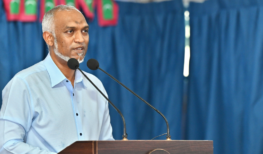Gov’t Targets Over 10 Percent Revenue Boost with New Fiscal Reforms

The Ministry of Finance announced a medium-term reform strategy projected to reduce state expenditure by an average of 1.1 percent annually while significantly increasing revenue and grants by an average of 10.9 percent.
The plan, which was presented during a parliamentary session, outlines a series of measures intended to ensure fiscal stability and debt sustainability over the coming years.
Key targets of the fiscal strategy include reducing state debt to 95 percent of GDP by the end of 2026 and maintaining the budget deficit below 5 percent of GDP each year.
Without the implementation of these reforms, the state anticipates a widening budget deficit, with revenue and grants projected at MVR 35.9 billion in 2025 against an expected expenditure of MVR 57.4 billion. In 2026, the gap is expected to persist, with MVR 38.3 billion in revenues against MVR 55.2 billion in expenditure.
The ministry warned that delays in enacting these stringent reforms could exacerbate the fiscal deficit, with the total state debt-to-GDP ratio projected to rise to 138.6 percent by 2026 and further to 139.4 percent by 2027.
Reforms Expected to Boost Annual Revenue to MVR 44.3 Billion by 2026
The proposed reforms include revising airport taxes and fees, increasing duties on unhealthy products, amending the GST Administration Act, expanding the tax base, and adjusting the Green Tax rate. With these measures, the ministry expects annual revenue to increase to MVR 44.3 billion by 2026, compared to the projected MVR 38.3 billion without reforms.
For the subsequent years, the ministry forecasts revenue projections for 2027 of MVR 40.9 billion without reforms and MVR 47.1 billion with reforms. In 2028, the projections are MVR 43.8 billion without reforms and MVR 50.5 billion with reforms.
The fiscal strategy suggests that if the reforms are successfully implemented, state revenue could reach 33.3 percent of GDP by 2028. The government also intends to seek USD 50 million in grants in both 2024 and 2025 to support these efforts.
Austerity measures included in the strategy involve the introduction of a targeted subsidy system for low-income earners, reforms to the state-initiated Aasandha insurance scheme, revisions to the Public Sector Investment Program (PSIP), and efforts to strengthen state-owned enterprises (SOEs).
Expenditure forecasts for 2025 anticipate MVR 57.4 billion without reforms and MVR 46.5 billion with reforms. For 2026, the expected expenditure is MVR 55.2 billion without reforms and MVR 45.5 billion with reforms. In 2027, expenditure is projected to be MVR 56.8 billion without reforms and MVR 46.6 billion with reforms. For 2028, the forecast is MVR 59.8 billion without reforms and MVR 49.2 billion with reforms.
Reforms Expected to Reduce Debt-to-GDP Ratio to 103% by 2026
The ministry projects that these reforms will help reduce the debt-to-GDP ratio to 103 percent by 2026, with a further decline to 93.8 percent by 2027. However, the government faces significant challenges in managing its debt obligations, particularly with USD 1 billion in debt repayments due in 2026. Some international financial institutions have expressed concerns about the government’s ability to meet these obligations.
In response, Finance Minister Dr. Mohamed Shafeeq announced plans to raise the Airport Development Tax (ADC) and Green Tax as part of a strategy to increase foreign currency revenue. These measures are designed to address the substantial debt repayments due in 2025 and 2026, including USD 500 million in 2025 and a further USD 500 million in 2026.
Dr. Shafeeq emphasised that the government is committed to generating revenue without overburdening citizens with additional taxes. He confirmed that there are no plans to raise GST, TGST, BPT, or withholding tax, and that the government aims to boost revenue in foreign currencies to service its debt obligations.
To manage the upcoming debt repayments, the government has also announced plans to secure a USD 300 million loan next year, which will be structured to minimise the repayment burden. Additionally, the Sovereign Development Fund (SDF) will be utilised to cover part of the debt, with efforts underway to attract additional investors to the fund.
Maldives’ total debt is expected to reach USD 8.37 billion by the end of this year, underscoring the urgency of implementing these fiscal reforms.






